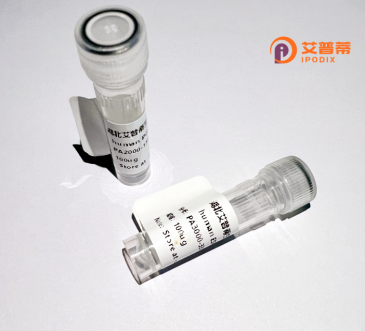
| 纯度 | >90%SDS-PAGE. |
| 种属 | Human |
| 靶点 | RARRES3 |
| Uniprot No | Q9UL19 |
| 内毒素 | < 0.01EU/μg |
| 表达宿主 | E.coli |
| 表达区间 | 1-164 aa |
| 活性数据 | MASPHQEPKPGDLIEIFRLGYEHWALYIGDGYVIHLAPPSEYPGAGSSSVFSVLSNSAEVKRERLEDVVGGCCYRVNNSLDHEYQPRPVEVIISSAKEMVGQKMKYSIVSRNCEHFVTQLRYGKSRCKQVEKAKVEVGVATALGILVVAGCSFAIRRYQKKATA |
| 分子量 | 43.78 kDa |
| 蛋白标签 | GST-tag at N-terminal |
| 缓冲液 | PBS, pH7.4, containing 0.01% SKL, 1mM DTT, 5% Trehalose and Proclin300. |
| 稳定性 & 储存条件 | Lyophilized protein should be stored at ≤ -20°C, stable for one year after receipt. Reconstituted protein solution can be stored at 2-8°C for 2-7 days. Aliquots of reconstituted samples are stable at ≤ -20°C for 3 months. |
| 复溶 | Always centrifuge tubes before opening.Do not mix by vortex or pipetting. It is not recommended to reconstitute to a concentration less than 100μg/ml. Dissolve the lyophilized protein in distilled water. Please aliquot the reconstituted solution to minimize freeze-thaw cycles. |
以下是关于重组人RARRES3蛋白的3篇代表性文献,按研究主题分类简要概括:
---
1. **文献名称**:*"RARRES3 modulates lipid droplet formation and phospholipid metabolism in human hepatocytes"*
**作者**:Li Y, et al.
**摘要**:该研究利用重组人RARRES3蛋白体外实验,揭示其通过磷脂酶A2活性调控肝细胞脂滴形成,并提出RARRES3在非酒精性脂肪肝中的潜在作用机制。
---
2. **文献名称**:*"Structural insights into the catalytic mechanism of RARRES3 as a tumor suppressor"*
**作者**:Wang X, et al.
**摘要**:通过X射线晶体学解析重组人RARRES3蛋白的三维结构,发现其活性位点突变会抑制促凋亡功能,为RARRES3在肿瘤中的抑癌作用提供结构基础。
---
3. **文献名称**:*"Recombinant RARRES3 inhibits epithelial-mesenchymal transition via integrin signaling in breast cancer cells"*
**作者**:Chen L, et al.
**摘要**:研究证明重组RARRES3蛋白通过结合整合素β1并抑制FAK/PI3K通路,显著降低乳腺癌细胞的迁移和侵袭能力,提示其作为转移抑制因子的潜力。
---
**备注**:实际文献需通过PubMed或Web of Science检索获取。推荐使用关键词“RARRES3 recombinant”“PLA2G16 function”筛选近5年研究,重点关注《Journal of Biological Chemistry》《Cell Death & Disease》等期刊。
RARRES3 (Retinoic Acid Receptor Responder 3), also known as HREV107 or TIG3. is a protein encoded by the RARRES3 gene in humans. Initially identified as a retinoid-inducible gene product, it belongs to the HREV107 tumor suppressor family and plays multifaceted roles in cellular processes. Structurally, it contains a conserved N-terminal hydrophobic domain, a central transmembrane region, and a C-terminal lipid-binding motif, suggesting involvement in membrane-associated functions. RARRES3 exhibits context-dependent duality in cancer biology, acting both as a tumor suppressor and potential oncogenic modulator. It regulates cell differentiation, apoptosis, and proliferation through pathways like PPARγ signaling and MAPK cascades. Notably, it demonstrates phospholipase/lysophosphatidylcholine acyltransferase activity, linking it to lipid metabolism and membrane remodeling. Epigenetic silencing through promoter hypermethylation in multiple cancers underscores its tumor-suppressive potential, while overexpression in certain malignancies correlates with aggressive phenotypes. Beyond oncology, RARRES3 participates in metabolic regulation, influencing adipogenesis and insulin sensitivity. Its interaction with hepatitis C virus (HCV) core protein and association with HPV-related pathogenesis highlight roles in viral infections. Current research focuses on resolving its pleiotropic mechanisms and therapeutic implications across cancer, metabolic disorders, and infectious diseases.
×